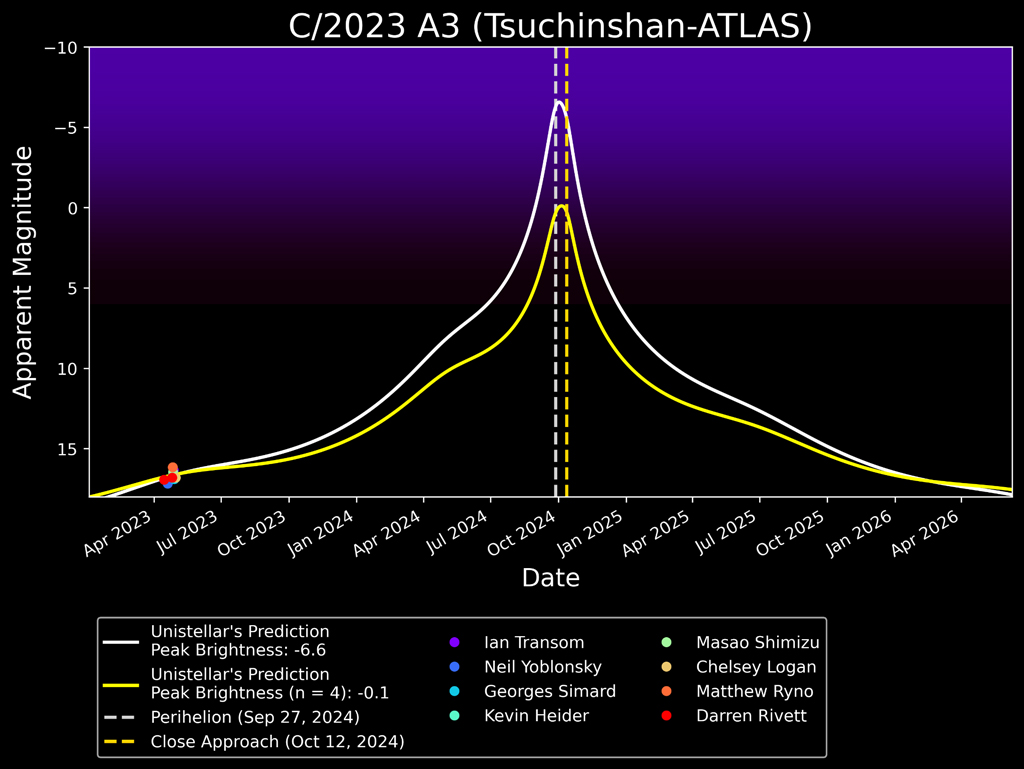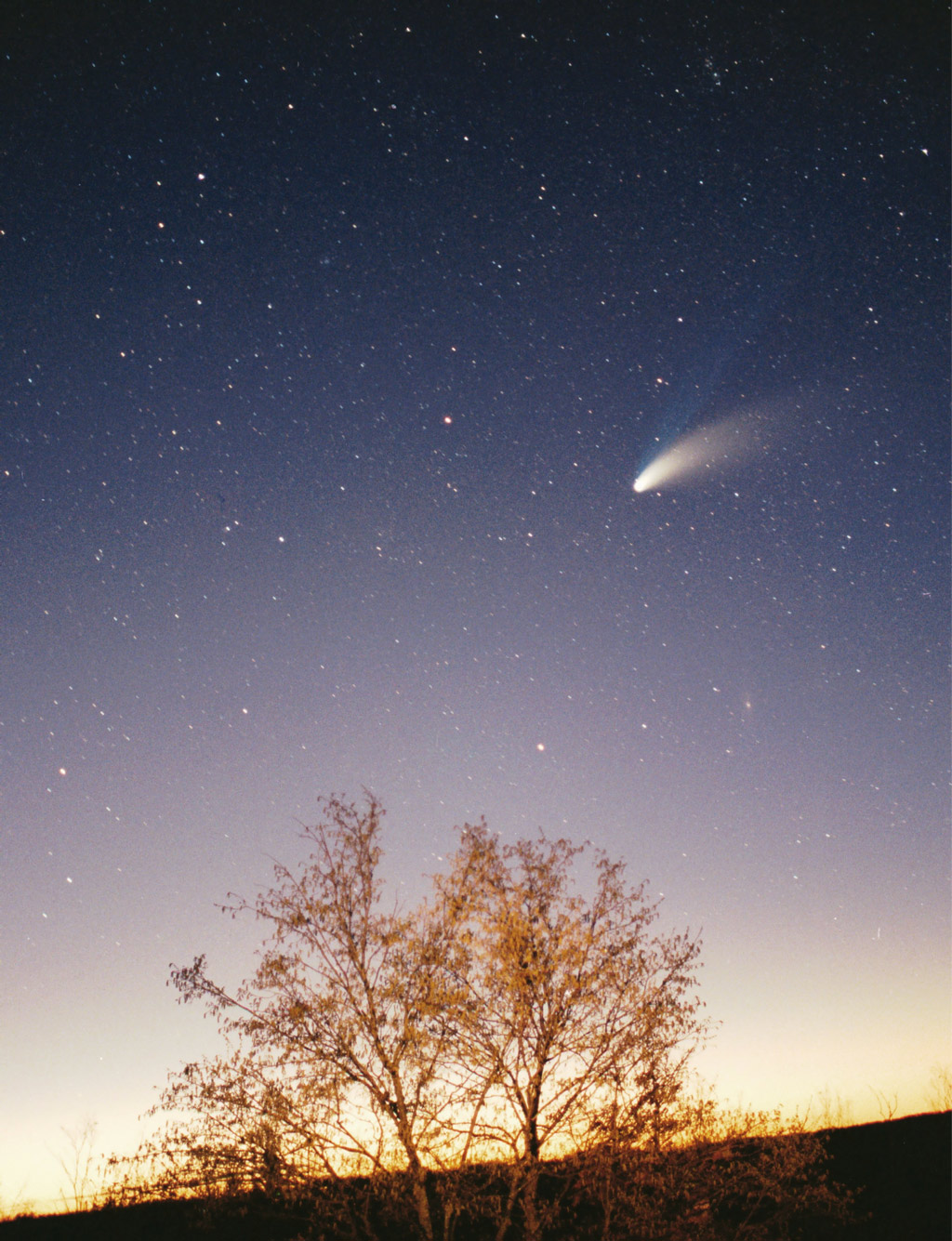
Earlier this year, shortly after the excitement of comet C/2022 E3, astronomers found another icy visitor grazing through their images. This comet, C/2023 A3 ( Tsuchinan-Atlas), was discovered independently by ATLAS in South Africa and Tsuchinsan Observatory in China - and given their namesake. But will this one be the great naked-eye comet of the decade we’ve been waiting for?
Luckily, observers with the SETI Institute/Unistellar Network, consisting of Citizen Astronomers armed with their smart Unistellar telescopes, are meaningfully contributing to science by watching the comet. So far, they have helped SETI researchers to see that comet C/2023 A3 might make all our comet dreams come true.
Comet C/2023 A3
Currently , C/2023 A3 is very faint as it flies outside Jupiter’s orbit, but the fun will peak next year when it skims closely past the Earth and the Sun. Its perigee, or closest approach to Earth, will occur on October 12, 2024 placing the comet less than 0.5 Earth-Sun distances (AU) from our planet. Perihelion will occur shortly before, on September 27, 2024..
Interestingly, both of these points in the comet’s orbit will position it between the Earth and Sun. This "forward scattering event" may bolster the comet's brightness. In this case, sunlight coming from behind the comet, according to our perspective on Earth , is scattered off of dust particles in the comet’s coma towards our eyes . As a result, the comet could appear brighter than we would expect, but there is a caveat – its sandwiching between the Earth and the Sun means the best viewing will occur during the evening or morning instead of the darkness of night.
All in all, it is still too soon for us to know precisely what C/2023 A3 will do. Astronomers are still unsure of the comet’s size, which could determine whether it breaks apart during an outburst of sublimation or stays intact. The type of ices and their distribution in the comet’s nucleus can also affect how its brightness will change. However, with the help of Unistellar Citizen Astronomers, these unknowns aren't keeping SETI scientists from trying to predict how C/2023 A3 will act.
Predicting A Comet’s Brightness
On April 14, through meticulous observations, comet C/2023 A3 revealed itself to the SETI/Unistellar Network of Citizen Astronomers. Darren Rivett made the first observations with the network in Australia Neil Yoblonsky from Florida. Although initially not expecting a detection, SETI Institute/Unistellar’s Cometary Activity program lead, Dr. Ariel Graykowski, combined the resulting images so that the faint presence of the comet was apparent. Her initial estimates measured an apparent magnitude of 17.2 for C/2023 A3, previously thought to be below the limits of the n etwork’s capabilities. These initial sightings shed light on the comet's current state and help astronomers to model its activity.
Though the comet's close approach is still distant, the scientific community has already begun to place its bets. Various predictions have emerged, highlighting the dynamic nature of these cosmic travelers, with several placing the comet’s 2024 brightness to outshine the brightest stars. Other forecasts are more conservative, insinuating that the comet will be visible through binoculars, at best. Graykowski employed different models for the data gathered by the SETI Institute/Unistellar Network to better understand the range of possibilities.

One of Graywkoski ’s brightness models, shown in white above, involves fitting the Citizen Astronomers’ data using both absolute magnitude and an "activity factor'' as free parameters. This activity factor determines how the sublimation of the comet’s ices contributes to its brightness as it gets closer to the Sun. However, our understanding of its activity remains incomplete, with limited observations of this particular comet. To account for this uncertainty, another fitting approach (shown in yellow) incorporates a fixed activity factor that aligns with typical values associated with comets. As more data comes in, these models will become more refined – but comets are notorious for being full of surprises!
The brightness model shown by the white curve in the figure above predicts a peak brightness of -6.6 for C/2023 A3 - nearly 100 times brighter than comet Hale-Bopp at its close approach in 1997! Comet Hale-Bopp was a large comet at 40 - 80 km in diameter; because of its size, it was visible to the naked eye for over 18 months. These predictions show that the younger generation, who missed out on the beauty of Hale-Bopp, might be inspired by the glory of a great naked-eye comet with C/2023 A3, depending on its size and makeup. C omet C/2023 A3 will come closer to Earth and the Sun than Hale-Bopp did!
As long as it survives its trip around the Sun, comet C/2023 A3 is bound to ignite a spark in the new generations on our planet. Even Graykowski’s conservative estimates, shown in yellow, place the peak brightness at -0.1, which is still brighter than all but a handful of stars in the sky.

As C/2023 A3 journeys closer to our corner of the solar system, researchers and citizen scientists will continue to gather data and watch it intently. T hrough the diligent efforts of astronomers and the power of the SETI Institute/Unistellar Network, we have obtained valuable glimpses into the early stages of this comet’s trek across the solar system to inform us about its future. Stay tuned for 2024!





